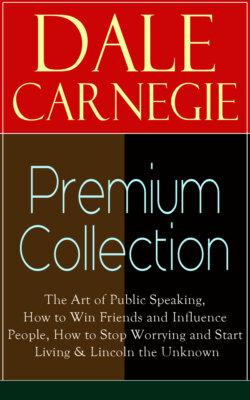Читать книгу DALE CARNEGIE Premium Collection - Dale Carnegie - Страница 62
На сайте Литреса книга снята с продажи.
QUESTIONS AND ANSWERS
Оглавление1. Write two paragraphs on one of these: the race horse, the motor boat, golfing, tennis; let the first be pure exposition and the second pure description.
2. Select your own theme and do the same in two short extemporaneous speeches.
3. Deliver a short original address in the over-ornamented style.
4. (a) Point out its defects; (b) recast it in a more effective style; (c) show how the one surpasses the other.
5. Make a list of ten subjects which lend themselves to description in the style you prefer.
6. Deliver a two-minute speech on any one of them, using chiefly, but not solely, description.
7. For one minute, look at any object, scene, action, picture, or person you choose, take two minutes to arrange your thoughts, and then deliver a short description—all without making written notes.
8. In what sense is description more personal than exposition?
9. Explain the difference between a scientific and an artistic description.
10. In the style of Dickens and Irving (pages 234, 235), write five separate sentences describing five characters by means of suggestion—one sentence to each.
11. Describe a character by means of a hint, after the manner of Chaucer (p. 235).
12. Read aloud the following with special attention to gesture:
His very throat was moral. You saw a good deal of it. You looked over a very low fence of white cravat (whereof no man had ever beheld the tie, for he fastened it behind), and there it lay, a valley between two jutting heights of collar, serene and whiskerless before you. It seemed to say, on the part of Mr. Pecksniff, "There is no deception, ladies and gentlemen, all is peace, a holy calm pervades me." So did his hair, just grizzled with an iron gray, which was all brushed off his forehead, and stood bolt upright, or slightly drooped in kindred action with his heavy eyelids. So did his person, which was sleek though free from corpulency. So did his manner, which was soft and oily. In a word, even his plain black suit, and state of widower, and dangling double eye-glass, all tended to the same purpose, and cried aloud, "Behold the moral Pecksniff!"
—Charles Dickens, Martin Chuzzlewit.
13. Which of the following do you prefer, and why?
She was a blooming lass of fresh eighteen, plump as a partridge, ripe and melting and rosy-cheeked as one of her father's peaches.—Irving.
She was a splendidly feminine girl, as wholesome as a November pippin, and no more mysterious than a window-pane.—O. Henry.
Small, shining, neat, methodical, and buxom was Miss Peecher; cherry-cheeked and tuneful of voice.—Dickens.
14. Invent five epithets, and apply them as you choose (p. 235).
15. (a) Make a list of five figures of speech; (b) define them; (c) give an example—preferably original—under each.
16. Pick out the figures of speech in the address by Grady, on page 240.
17. Invent an original figure to take the place of any one in Grady's speech.
18. What sort of figures do you find in the selection from Stevenson, on page 242?
19. What methods of description does he seem to prefer?
20. Write and deliver, without notes and with descriptive gestures, a description in imitation of any of the authors quoted in this chapter.
21. Reëxamine one of your past speeches and improve the descriptive work. Report on what faults you found to exist.
22. Deliver an extemporaneous speech describing any dramatic scene in the style of "Midnight in London."
23. Describe an event in your favorite sport in the style of Dr. Talmage. Be careful to make the delivery effective.
24. Criticise, favorably or unfavorably, the descriptions of any travel talk you may have heard recently.
25. Deliver a brief original travel talk, as though you were showing pictures.
26. Recast the talk and deliver it "without pictures."
